Forget about macrophotography, iPhone astrophotography could be the next big thing in smartphone imaging. Just take a look, if you will, at the awesome detail that one photographer was able to extract from an image of the Milky Way captured on iPhone 13 Pro Max.
STORY HIGHLIGHTS:
- John Kraus took a 30-second Milky Way exposure on his iPhone 13 Pro Max
- He shot the night sky photograph in Apple’s ProRAW format
- ProRAW enables greater creative control when editing photos
- He edited the ProRAW file in Lightroom CC on his iPhone
The Milky Way, straight out of the iPhone 13 Pro Max camera
Taking night sky images with Apple’s latest iPhone tens to produce more than satisfactory results, assuming you know what you’re doing. Although image quality isn’t there yet compared with a professional rig, it’s pretty impressive for a smartphone.
John Kraus aka “Snap“” is a spaceflight photographer who captures “Earth’s out-of-this-world moments,” according to his bio on Twitter. Kraus is a guy who definitely knows what he’s doing when he points his iPhone camera at the night sky. What you’re seeing below is a 30-second exposure of the Milky Way he took with his iPhone 13 Pro Max.

And here’s the same image after a few relatively simple post-processing edits.

The key? Shooting in Apple’s ProRAW format.
Shooting in ProRAW on your iPhone
Even though ProRAW files are 10 to 12 times larger than HEIF or JPEG files, they store image data as captured by the camera, accompanied by minimal iPhone post-processing. So rather than being served an AI-enhanced image that has undergone a bunch of post-processing steps that cannot be reverted, you get raw sensor data.
This gives you much greater creative freedom and flexibility when editing crucial image aspects such as exposure, color and white balance. You can literally pull out the detail, especially from very dark areas of a photo, that you never knew existed (feel free to dive into Apple’s support document to learn about the ins and outs of shooting in ProRAW).
That’s precisely what Kraus has done with his photo of the Milky Way. He shared the original ProRAW image straight out of the camera and its edited counterpart. We’d be curious to learn about the particular edits he applied to the ProRAW file to extract such awesome detail.
Even Kraus himself appears to be taken aback by the results he was able to achieve. “Has me excited for where phone cameras might be in a few years,” he wrote on Twitter.
Be sure to check out his portfolio at johnkrausphotos.com.
What happened to iPhone astrophotography mode?
Shooting in ProRAW is easy, but editing ProRAW files requires knowledge of photography that goes beyond pressing the shutter button and moving a few sliders in Photoshop. But in a year or two, your iPhone could do all the heavy lifting on your behalf and allow you to take clear night sky photos that don’t require any processing.
You’d just point your iPhone at the night sky and hit the shutter button, with Apple’s computational photography automatically pulling out all the relevant detail, like stars, nebulas and so on. We’re not lying! Prominent leaker Max Weinbach said in February 2021 that the iPhone 13 models would feature a cool new feature: astrophotography mode.
Well, the new iPhones are here but astrophotography mode is nowhere to be found. But we’re optimists and Weinbach’s description certainly sounds interesting. He says you’re going to point your iPhone up at the sky and AI will detect objects like stars or the moon. The phone will then automatically switch to this mode optimized for night sky photography. Read: How to take long exposure photos on iPhone
It will use even longer exposure times and more internal processing to capture beautiful images of the night sky. Sounds great, and we hope this is one of those features that Apple delayed to smooth out the rough edges. It would be great to have astrophotography mode delivered to the current iPhone users via a future iOS 15 update.